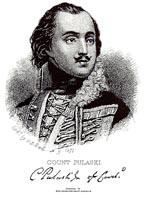 |
THE PULASKI CLUB WILLIAMSBURG, VIRGINIA (Founded 1779) |
 |
THE PULASKI CLUB WILLIAMSBURG, VIRGINIA (Founded 1779) |
A Brief History of Count Casimir Pulaski, "Father of the American Cavalry"
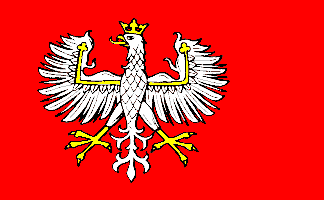 |
Casimir Pulaski was born on March 4, 1747*, in Winiary, Poland, some 40 miles outside of Warsaw. His family belonged to the minor Polish nobility, and his ancestors fought with King Jan Sobieski against the Turks at the siege of Vienna in 1683. His father Jozef had successfully built up the family fortune with strong ties to the Czartoryski, with whose nationalist policies he was identified, as Poland came increasingly under the domination of its aggressive neighbors, particularly Tsarist Russia. |
In 1768, Jozef Pulaski became impatient with the Russian interference and joined with others in initiating an insurrection known as the Confederation of Bar, named for a town in the Ukraine where it was formed. Under the motto, "For Faith and Freedom", the elder Pulaski assumed the military leadership of the Confederation, and at age 21 Casimir took command of a detachment of partisans. For the next 3 1/2 years, the young commander proved his valor and genuine military talent in more than a dozen major actions and numerous skirmishes against the Russians. His greatest success was in the taking and holding of Jasna Gora at Czestochowa, the most holy place in Poland. His brilliant defense against Russia thrilled all of Europe. In October 1771, Pulaski undertook one last major expedition as part of a plot to abduct the king. The plan failed, and the young Casimir was unjustly accused of attempted regicide. In the face of the charges against him, he was forced to flee his homeland, never to return.
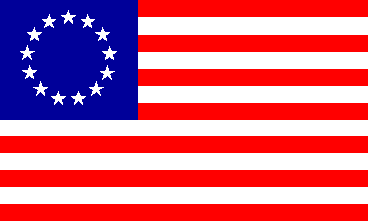 |
Exiled to France, Count Pulaski learned of America's war for independence and sought permission to join the fight for freedom. In May 1777, Pulaski received a letter of recommendation from Benjamin Franklin, the American commissioner in Paris, and enlisted in the American cause. He landed near Boston in July, and by August he had reported to General Washington's headquarters near Philadelphia. |
| Pulaski joined George Washington's army just before the battle of Brandywine. Acting under Washington's orders and without a commission, Pulaski lead a scouting party that discovered the British flanking movement and the American escape route. He then gathered all available cavalry to cover the retreat, leading a dashing charge that surprised the British and allowed the American army to escape. Congress rewarded Pulaski with a commission as brigadier general and command of all American cavalry. He spent the winter of 1777-1778 training and outfitting the cavalry units but in March, he gave way before the intrigues of his jealous officers who did not share his conception of the cavalry as a separate combat force. Pulaski asked to be relieved of his position and allowed to form a special infantry and cavalry unit capable of more independent action. With Washington's support, Pulaski gained the consent of Congress on March 28, 1778. He then took another five months to form his legion at his headquarters in Baltimore. | 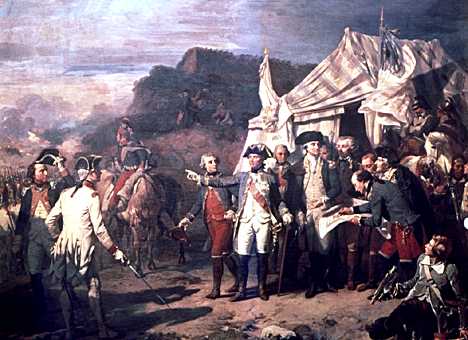 |
He recruited Americans, Frenchmen, Poles, Irishmen, and especially Germans, who were mainly deserters from the Hessian mercenaries employed by the British. Pulaski's Legion became the training ground for American cavalry officers including "Light Horse" Harry Lee, the father of Robert E. Lee, and the model for Lee's and Armand's legions. The best assessment of Pulaski's legion came from a British officer who called them simply "the best damned cavalry the rebels ever had".
For some time the American command could not find a suitable role for Pulaski's Legion, leading him again to request reassignment. On February 2, 1779, he received orders to proceed to South Carolina to reinforce the southern American forces under British attack. Now Pulaski began his most active period of service in the war with the front line combat he sought. At the head of a troop of some 600, Pulaski arrived in Charleston in May 1779, just in time to contribute to its successful defense against a much larger British force. This victory proved pivotal in the war in the South as it broke the British momentum and boosted American morale.
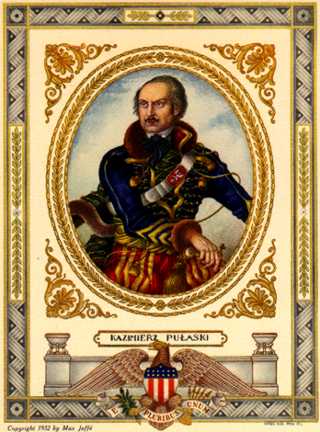 |
The next step was to win back the
territory that the British had occupied. Savannah became
the fateful goal. Newly arrived French forces under
Admiral Charles Henri d'Estaing joined the Americans to
plan a risky all out assault on the heavily fortified
town. The siege began on October 9. The mission of the
Pulaski Legion was to follow the French infantry and
break down the enemy's line of defense. When the French
got caught in a cross fire, d'Estaing himself was wounded
and Pulaski could see the infantry breaking ranks under
heavy fire. To save the situation, he charged forward
into the battle and was mortally wounded by British
cannon shot. Carried from the battlefield, he was put on
a ship to be taken to Charleston, and never regained
consciousness. On October 11, 1779, Count Pulaski died at
sea, where he was buried.* Casimir Pulaski was the romantic embodiment of the flashing saber and the trumpet calling to the charge, and that is how history remembers him. The larger-than-life aspect of his death has often obscured his steadier and more lasting services. It was in the discipline of forging a skilled American cavalry that could shadow and report on British movements, complete long distance forage raids to feed and clothe the troops at Valley Forge, and force the bitter hit and run rearguard actions to slow British pursuit and cover retreating American armies that gave Pulaski the title of "Father of the American cavalry". |
LINKS
Pulaski Club Home Page * 225th Anniversary Dinner * History of Count Casimir Pulaski * 227th Anniversary Dinner
![]()
*The date of Count Pulaski's birth is still being debated by scholars who cite different sources to support each theory. This has led to confusion regarding his true age at the time of the heroic charge on Savannah in 1779. Estimates range from 31 to 35 years of age. Some alternative theories have also been recently espoused whereby Count Pulaski died at sea but was brought ashore and buried on a Georgia plantation owned by the Bowen family.
Thank you for visiting the official site of the Pulaski Club in Williamsburg, Virginia. The Pulaski Club is not responsible for the content on this page. The Pulaski Club of Williamsburg, Virginia is not particularly responsible for anything at all, except to keep the oral history of Williamsburg alive and spread local lore to future generations of Pulaski Club members in Historic Williamsburg, Virginia.
Thanks to these sources: Colonial Williamsburg
Foundation, Williamsburg, Va; Casimir Pulaski 1747-1779 A Short
Biography, written by John J. Kulczycki, Professor of History,
University of Illinois at Chicago; Published by the Polish Museum
of America, Chicago, IL; and Casimir Pulaski: Father of American
Cavalry by Richard Lysiak